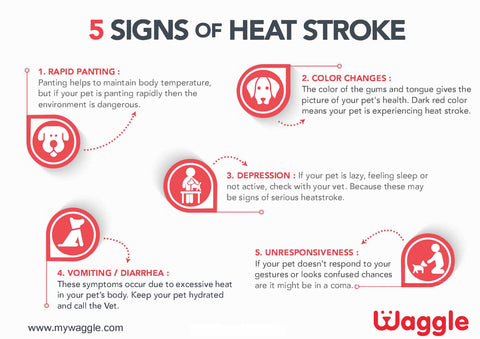Heat stroke in Dogs
Heatstroke is a severe condition that can occur in dogs when their body temperature rises to dangerous levels. This can happen when they are exposed to high temperatures or engage in vigorous exercise without proper hydration. It's important to understand the symptoms of heatstroke in dogs, what causes it, and how to prevent it.
Symptoms of Heatstroke in Dogs

It's important to recognize the symptoms early so you can seek veterinary care as soon as possible. Some of the common symptoms of heatstroke in dogs include.
1. Heavy panting
2. Rapid heartbeat
3. Vomiting
4. Diarrhea
5. Glazed eyes
6. Increased body temperature
7. Dehydration
8. Disorientation
9. Muscle tremors or seizure
10. Collapse or unconsciousness
If you found that your dog is experiencing heatstroke, taking immediate action is important. Remove them from the hot environment, provide shade and fresh water, and cool them down using cool (not cold) water. Seek veterinary care as soon as possible.
Also Read: Understanding the Different Types of Dog Panting
Causes of Heatstroke in Dogs
Heatstroke in dogs can be caused by a variety of factors, including.
1. Exposure to high temperatures: Dogs can suffer heatstroke when left in a hot car, outdoors in direct sunlight, or in a poorly ventilated area.
2. Exercise: Over exercising can increase a dog's body temperature, especially if they are not properly hydrated.
3. Obesity: Overweight dogs are more prone to heatstroke because they have a harder time regulating their body temperature.
4. Brachycephalic breeds: Brachycephalic breeds, such as bulldogs, pugs, and Boston terriers, have short snouts and airways so it will be more difficult to breathe and regulate their body temperature.
5. Health issues: Certain medical conditions, such as heart disease, can increase a dog's risk of heatstroke.
Prevention of Heatstroke in Dogs
Fortunately, heatstroke in dogs can be prevented. Here are some steps and first aid to prevent your dog from heatstroke.
1. Limit exposure to high temperatures: Keep your dog in a cool, air-conditioned environment during hot weather. Avoid leaving them in a hot car or outside in direct sunlight for extended periods.
2. Provide plenty of fresh water: Make sure your dog has access to fresh water, especially during exercise and hot weather.
3. Gradually acclimate your dog to exercise: If your dog is not used to exercise, start slow and gradually increase the intensity and duration. Make sure they are properly hydrated before, during, and after exercise.
4. Keep your dog at a healthy weight: Overweight dogs are more prone to heatstroke.
5. Avoid exercise during the hottest parts of the day: Exercise your dog during cooler parts, such as early in the morning or late in the evening.
6. Watch for signs of heat exhaustion: Pay attention to your dog's behavior and look for signs of heat exhaustion, such as panting, rapid heartbeat, and disorientation. If you notice any of these symptoms, immediately remove them from the hot environment and provide shade and fresh water.
The Bottom-line
In conclusion, heatstroke in dogs is a severe condition that can occur when a dog's body temperature rises to dangerous levels. It can be caused by exposure to high temperatures, vigorous exercise without proper hydration, obesity, brachycephalic breeds, and certain medical conditions.
Recognizing the symptoms of heatstroke in dogs early and taking immediate action is critical. Prevention is key, and steps such as limiting exposure to high temperatures, providing plenty of fresh water, gradually acclimating your dog to exercise, keeping them at a healthy weight, avoiding exercise during the hottest parts of the day, and watching for signs of heat exhaustion can help keep your dog safe. Seek veterinary care as soon as possible if your dog got heatstroke.











